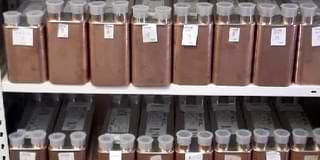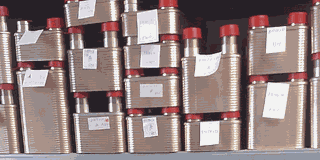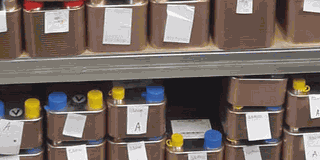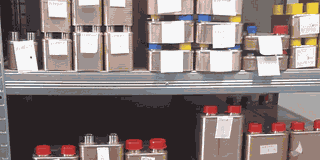We offer SWEP, Alfa Laval and ARES plate heat exchangers
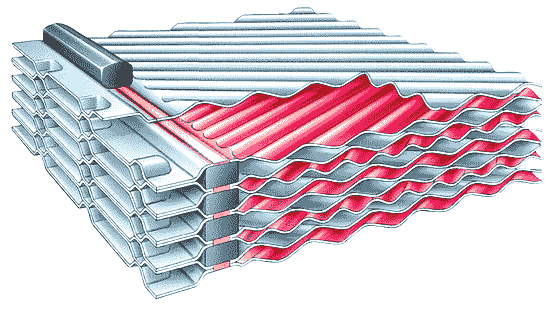
What is a heat exchanger?
A heat exchanger is a device that efficiently transfers heat between two media. The medium for heat transfer can be, for example, water (used in circuits for heating, cooling, or swimming pools). How does a heat exchanger work? The thin walls of the exchanger separate the two media and enable heat transfer without mixing them. ... (click to expand the paragraph)
A heat exchanger is a device that efficiently transfers heat between two media. The medium for heat transfer can be, for example, water (used in circuits for heating, cooling, or swimming pools). How does a heat exchanger work? The thin walls of the exchanger separate the two media and enable heat transfer without mixing them. Through the conduction of heat across the walls, the cooler medium is heated, and the warmer one is cooled. An example would be an oil cooler that removes heat from hot oil and simultaneously heats cold water.

What are the heat exchangers used for?
In systems for waste heat recovery. In heating stations, they take heat from hot steam to be distributed to apartments (hot water, heating). In households, heat exchangers transfer heat to rooms (radiators). In cars or in the cooling industry. In refrigerators and boilers. Hot water exchangers are also part of air conditioners and heat pumps.
Types of exchangers
The purpose determines which type of exchanger is suitable, as each type has advantages and disadvantages. Most often used types are
- plate exchangers (either brazed or gasketed), are connected in countercurrent, thus achieving high efficiency;
- shell-and-tube heat exchanger (large, not very efficient, but can be designed for extreme pressures and temperatures);
- U-tube heat exchangers, i.e. tubular exchangers arranged in such a way that they are not sensitive to expansion;
- Tube in Tube, they can be connected in countercurrent, a further increase in efficiency is achieved by ribbing;
- furnace Water to Air exchangers also used for cooling the medium in the tube;
- immersion coil exchangers etc.
Tubular heat exchangers are often manufactured for a given project. Plate heat exchangers are manufactured in series, so they are cost-effective. Plate heat exchangers with gaskets can be disassembled and their output can be additionally increased.
What materials are being used for exchangers?
It is usually made of metals, stainless steel AISI 304, AISI 316. Steel SMO 254 is resistant to chlorides and some acids, suitable for use with salt water or H2SO4. Titanium exchanger is designed for use with chemicals, chlorides and abrasive media.
Plastic heat exchangers may be suitable for corrosive media. Ceramic heat exchangers for very high temperatures. Graphite has a high thermal conductivity and is resistant to very aggressive media. A thin plate is better for optimal heat transfer, but a thick one is more durable.
SWEP and Alfa Laval brazed plate heat exchangers
We sell a very wide range of compact conventional heat exchangers at low prices.. Brazed plate heat exchangers are extremely efficient for heat exchange:
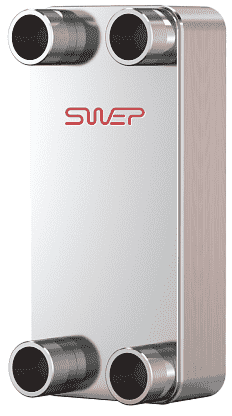
- as a water/water exchanger, i.e. especially for
- heating (water heating, DHW heating, drinking water, heating, separation exchanger, biogas stations),
- for heating and district stations, also as
- steam exchangers,
- in industry (food, chemical),
- brewing (wort cooling),
- machine cooling (oil/water heat exchanger, i.e. as industrial oil coolers),
- swimming pool heating,
- solar systems, condensing and non-condensing gas boilers,
- heat pumps,
- evaporators, condensers, etc.
We supply plate brazed and gasketed heat exchangers for various pressures and media, in the basic range made of stainless steel AISI 316. According to customer requirements, heat exchanger plates can be made of even higher quality stainless steel (254 SMO, titanium). Different types of channels (H, M, L) are also available. The price list of heat exchangers shows our good value heat exchangers at high quality.
The lowest range (E5, E6, E8) is designed for pressures of 10 bar.
Most heat exchangers are designed for pressures of 45 to 50 bar and can also be
used for high pressures (EU declaration of conformity). The special
design of high-pressure plate heat exchangers allows use up to a
pressure of
140 bar ![]() ,
e.g. for applications with methane or CO2.
,
e.g. for applications with methane or CO2.
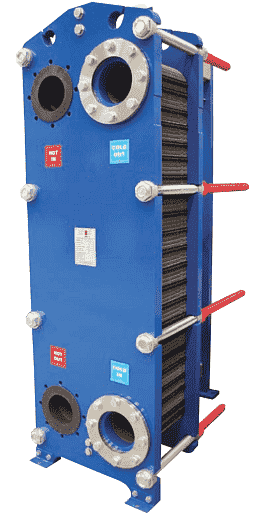
Gasketed plate heat exchangers ARES and Alfa Laval
We sell wide range of gasketed heat exchangers at low prices. Tradition guarantees high quality. They have excellent thermal conductivity. The plate heat exchanger is intended for wide use in industry, food industry and especially for district heating or as industrial coolers. Suitable for aggressive media. They have small hydraulic losses.
The basic series is made of stainless steel AISI 316L, AISI 304L. According to customer requirements, heat exchanger plates can be provided from even higher quality 254 SMO stainless steel or titanium steel. The choice of steel quality does not affect the efficiency of the exchanger, only its resistance to corrosion. Different types of channels (H, M, L) are available. The connections are external thread DN32, DN50 for small exchangers. For larger exchangers the connections are standard flanges DN65 to DN500.
Contact us with your requirements so that we can perform the necessary calculations and recommend the most suitable one for you at the best price.
Installation and maintenance instructions
- Manual for installation and maintenance of brazed heat exchangers can be downloaded here.
- Manual for installation and maintenance of gasketed heat exchangers ARES can be downloaded here.
- We suggest you connect the exchanger as a countercurrent, as when installed as a cocurrent, the output is about half.
- Never expose the unit to pulsations or excessive cyclic pressure or temperature changes.
- It is also important that no vibrations are transferred to the BPHE. If there is a risk of this, install vibration absorbers.
- Install condensate drainage in steam systems. Condensate backs-up in the heat exchanger and induces on/off regulation. This leads to wear on the control valve, the risk of cavitation
- For single-phase applications such as water/water, water/oil, the orientation of the exchanger has almost no effect.
- There are many different connections, the standard is a ISO G external thread.
Solder connections:
- The connection are made of stainless steel.
- It is recommended that all soldering uses silver solder containing at least 45% silver.
- It is important to degrease and polish the surfaces when soldering.
- Point the flame towards the piping and braze at max. 650 °C (1200 °F). Protect the unit from excessive heating by a wet cloth around the connection.
- Avoid internal oxidation, e.g. by protecting the inside of the refrigerant side with nitrogen gas (N2).
Other notes:
- If any of the media contain particles larger than 1 mm, we recommend that a strainer with a size of 1 mm will be installed before the inlet of BPHE.
- If the temperature difference between the primary and secondary side is higher than 100 K, the heat exchanger must be started up slowly. Otherwise there is a risk of material fatigue and therefore short service life.
- Protect the heat exchanger and media from freezing.
Corrosion
All the exchangers we sell are made of stainless steel (some AISI 304, most AISI 316). Corrosion of copper solder (more common case) or steel plates can be caused by less common impurities in the water. Particularly harmful are chlorides, sulphites, iron (rust), conductivity, pH value, etc. Even drinking water can be aggressive towards copper if it contains unfavorable impurities.
Deionized water is equivalent to distilled water. Both anions and cations have been removed from the water. Deionized water is usually aggressive to all metals except noble metals such as gold and platinum. For the use of deionized water appropriate inhibitors have to be added, such as Benzotriazole. Unless proper inhibitors are added, it is recommended to use an All-stainless units or those with nickel brazing.
In more than 95% of cases, the typical AISI 316 copper brazed design is suitable. Corrosion occurs in old heating systems, where rusted heating elements release iron and manganese into the heating water. Especially in systems with an open expansion tank, where oxygen enters the water. Rusty water will corrode the copper solder and reduce the life of the heat exchanger. If the object has an outdated heating system, the water must be reviewed, replaced, and a corrosion inhibitor should be used.
Influence of water composition on corrosion resistance
The higher the temperature of the medium, the greater the corrosion effects. In many applications, capacity can be designed for higher flow rates and thus lower temperatures to reduce adverse effects of corrosion.
- + good resistance under normal conditions
- 0 corrosion problems may occur especially if it is a combination of several adverse factors
- - use is not recommended
| Concentration | Plate material | Brazing material | ||||
|---|---|---|---|---|---|---|
| mg/l, ppm | AISI 304 | AISI 316 | SMO 254 | copper | nickel | |
| Organic deposits | 0 | + | + | 0 | 0 | |
| Alkalinity HCO3- | < 70 | + | + | + | 0 | + |
| 70–300 | + | + | + | + | + | |
| > 300 | + | + | + | 0 | + | |
| Sulphate SO42- | < 70 | + | + | + | + | + |
| 70–300 | + | + | + | + | + | |
| > 300 | 0 | 0 | + | - | + | |
| Ratio HCO3-/SO42- | > 1,0 | + | + | + | + | + |
| < 1,0 | + | + | + | 0/- | + | |
| Electrical conductivity | < 10 µS/cm | + | + | + | 0 | + |
| 10–500 µS/cm | + | + | + | + | + | |
| > 500 µS/cm | + | + | + | 0 | + | |
| pH | < 6 | 0 | 0 | 0 | 0 | + |
| 6–7,5 | + | + | + | 0 | + | |
| 7,5–10 | + | + | + | + | + | |
| > 10 | + | + | + | 0 | + | |
| Ammonium NH4 | < 2 | + | + | + | + | + |
| 2–20 | + | + | + | 0 | + | |
| > 20 | + | + | + | - | + | |
| Chlorides | < 300 | chlorides are in detail | + | + | ||
| > 300 | in the below table | 0/- | + | |||
| Free chlorine Cl2 | < 1 | + | + | + | + | + |
| 1–5 | + | + | + | 0 | + | |
| > 5 | + | + | + | 0/- | + | |
| Hydrogen sulfide H2S | < 0,05 | + | + | + | + | + |
| > 0,05 | 0 | + | + | 0/- | + | |
| Free (aggressive) CO2 | < 5 | + | + | + | + | + |
| 5–20 | + | + | + | 0 | + | |
| > 20 | + | + | + | - | + | |
| Total hardness °dH | 4–8,5 | + | + | + | + | + |
| Nitrate NO3 | < 100 | + | + | + | + | + |
| > 100 | + | + | + | 0 | + | |
| Iron | < 0,2 | + | + | + | + | + |
| > 0,2 | + | + | + | 0 | + | |
| Aluminium | < 0,2 | + | + | + | + | + |
| > 0,2 | + | + | + | 0 | + | |
| Manganese | < 0,1 | + | + | + | + | + |
| > 0,1 | + | + | + | 0 | + | |
| (click to expand other rows) | ||||||
The standard version of the SWEP heat exchanger is in AISI 316 quality (DIN 1.4401). Some heat exchangers are in AISI 304 quality (DIN 1.4301) and SWEP Minex heat exchangers also available with Titan Grade 1 plates (DIN 3.7025). ARES heat exchangers are available as AISI 304L, AISI 316L, Titan Grade 1 and SMO 254.
| Max. temperature | |||||
|---|---|---|---|---|---|
| Chlorides content | 30 °C | 60 °C | 80 °C | 120 °C | 130 °C |
| 10 ppm | 304 | 304 | 304 | 304 | 316 |
| 25 ppm | 304 | 304 | 304 | 316 | 316 |
| 50 ppm | 304 | 304 | 316 | 316 | Ti/254 SMO |
| 50 ppm | 304 | 304 | 316 | 316 | Ti/SMO |
| 80 ppm | 316 | 316 | 316 | 316 | Ti/254 SMO |
| 80 ppm | 316 | 316 | 316 | 316 | Ti/SMO |
| 150 ppm | 316 | 316 | 316 | Ti/254 SMO | Ti/254 SMO |
| 150 ppm | 316 | 316 | 316 | Ti/SMO | Ti/SMO |
| 300 ppm | 316 | 316 | Ti/254 SMO | Ti/254 SMO | Ti/254 SMO |
| 300 ppm | 316 | 316 | Ti/SMO | Ti/SMO | Ti/SMO |
| > 300 ppm | Ti/254 SMO | Ti/254 SMO | Ti/254 SMO | Ti/254 SMO | Ti/254 SMO |
| > 300 ppm | Ti/SMO | Ti/SMO | Ti/SMO | Ti/SMO | Ti/SMO |
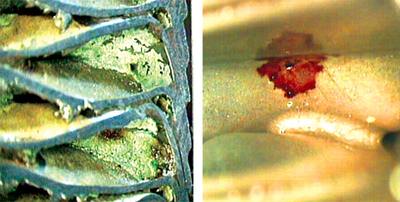
1 — Rusty water (e.g. from outdated radiators) corrodes copper solder.
2 — Salt water corrodes stainless steel.
The higher the temperature of the medium, the greater the corrosion effects. If the heat exchanger is exposed to an unfavorable environment, then a special version is installed, i.e. a heat exchanger without solder (All-stainless) or a titanium heat exchanger. In many applications, the heat exchanger can be designed for lower temperatures at higher flow rates. This maintains performance and eliminates the aggressive effect of the medium.
Scaling, limescale
Sodium carbonate and magnesium carbonate are referred to as salts and cause water hardness. If there is a risk of limescale deposits formation (also called fouling), we recommend descaling the water (adding acids or specific chemicals tailored to inhibit the precipitation of the compound. Scale build-up occurs most at temperatures above 60 °C. To prevent scale build-up on the heat exchanger plates.
- design for higher flow rate and lower temperatures to transfer the same heating load.
- In addition, the higher flow rate causes turbulent flow in the channels between the plates, and this type of flow gives to the exchanger self-cleaning ability.
- It is often advisable to design the DHW exchanger as a cocurrent. A slightly larger exchanger will be needed, but the DHW will not overheat.
- Supply cold DHW to the lower inlet of the heat exchanger. The upward flow of water reduces the clogging of channels with deposits.
Heat exchanger cleaning
Scale: we recommend cleaning the heat exchanger with 5% phosphoric acid or 5% oxalic acid. Acids corrode the copper brazing used to connect the exchanger plates. Therefore, neutralize with 1-2% sodium hydroxide (NaOH) or sodium bicarbonate (NaHCO3). The biological/organic growth can be purified with 4% sodium hydroxide. For optimal cleaning, the flow rate of the cleaning solution should be at least 1.5 times the normal flow rate, but in the opposite direction. The temperature during cleaning should not exceed 80 °C, at higher temperatures the corrosive effect increases and the exchanger may get damaged.


